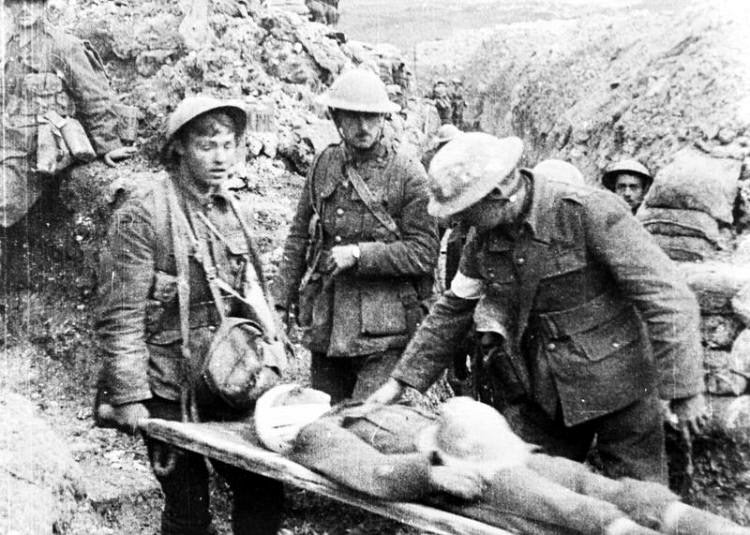
Peter Nelson was born at Thruscross in 1889, the fourth child and third son of eleven children born to William Nelson and his wife Mary (nee Heaton) who married at Pateley Bridge in 1878.
In 1891 and 1901 farmer and agricultural labourer William Nelson, his wife Mary and their family were living at Thruscross, Barnsley. By 1911, Peter Nelson had left home and was living and working at Low Park Farm, Ossett where he was a horseman working for farmer Bertram Waterhouse.
Peter Nelson’s army service record has not survived, but it is known that he enlisted at Ossett and joined the 1st/4th Battalion, King’s Own Yorkshire Light Infantry with regimental service number 1529. He embarked for France on the 13th April 1915 and he was killed in action on the 7th July 1916. He was posthumously awarded the British and Victory medals and also the 1914/15 Star in recognition of his service overseas before 31st December 1915.
The KOYLI 1st/4th Battalion was formed in August 1914 at Wakefield as part of the 3rd West Riding Brigade, West Riding Division. They moved on mobilisation to Doncaster and in November 1914 to Gainsborough, then again to to York in February 1915. On the 12th April 1915 they landed at Boulogne and on the 15th May 1915, the formation became 148th Brigade, 49th (West Riding) Division.
On the 7th July 1916, the 1st/4th Battalion, KOYLI were in the Thiepval sector during the Battle of the Somme, taking part in an attack on the village of ‘Ovillers’ (North of Thiepval on the Albert-Bapaume Road). Their “War Diary” for the 7th July 1916 records the following:
“12:30 a.m. – Enemy opened intense bombardment on original British front line. This continued until 2:15 a.m., our artillery replying effectively.”
“02:15 a.m. – The bombardment was turned on to the ‘A’ Line until 02:50 a.m. when it was turned again on to the communications trenches and lines behind.”
“02:50 a.m. – Enemy bombers advanced down the trench towards A.18 and A.16 and across the open to A.17, a furious fight with bombs ensued lasting until 06:30 a.m. Numerous casualties were incurred both from bombs, and enemy snipers who were lying out in the open and who shot down our men as they fired and threw bombs out of the trench. Major H. Moorhouse, D.S.O. in command of the sector was wounded in the arm by a sniper about 04:00 a.m., but remained in command until 05:30 a.m. when forced through loss of blood to go to the Dressing Station, Captain W. M. Williamson, commanding ‘Z’ Company, and 2/Lts. Carter, Massie, Mackay, De Jonquet and Huntington were also wounded. Capt. H.G. Fraser took command and continued the fight until 06:30 a.m. when he ran out of bombs and was forced to retire down the communications trench to the original British Front Line which he held along with the 4th and 5th Y. & L. Regiment already there with the 35 men remaining out of the two companies until 09:30 a.m. when he was ordered to return to the Assembly Trenches in Thiepval Wood.”
“Casualties: Other Ranks, 20 killed and 180 wounded.”
Peter Nelson was not remembered on any Ossett Memorial or Roll of Honour perhaps because he probably only came to Ossett shortly before 1911. He came for work and was not accompanied by other members of his family who may otherwise have sought for him to be remembered on the town’s memorial. He is remembered in this 2014 biography and Roll of Honour because the Commonwealth War Graves Commission and/or the “U.K. Soldiers who Died in the Great War 1914-1918” listing records him as born or residing in Ossett.

Above: Wounded soldier at the Battle of the Somme, July 1916.
Private Peter Nelson, died on the 7th July 1916 at the Battle of the Somme and is buried at grave reference F. 28. at the Authuile Military Cemetery,1 Somme, France. Authuile (now Authuille), is a village 5 km north of Albert. Authuile Military Cemetery is on the south side of the village. The Cemetery is signposted on the main road (D159) through the village.
The village was held by British troops from the summer of 1915 to March, 1918, when it was captured in the German Offensive on the Somme; it was ruined by shell fire even before that date.
The Military Cemetery was used by Field Ambulances and fighting units from August, 1915 to December, 1916, and in 1917 and 1918 by Indian Labour Companies.
There are now over 450, 1914-18 war casualties commemorated in this site. Of these, nearly 40 are unidentified and special memorials are erected to 18 soldiers from the United Kingdom, known or believed to be buried among them. The graves of two other German soldiers have been removed.
The cemetery covers an area of 2,650 square metres and is enclosed by a low concrete curb. The cemetery was named as Authuile Military Cemetery at the time of creation and C.W.G.C. maintain this as the historic name of the cemetery.
CWGC heastone photograph courtesy of Mark Smith
References: